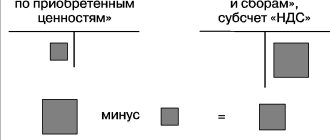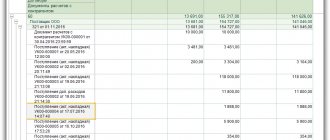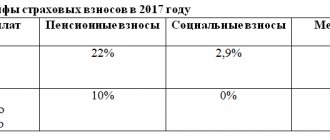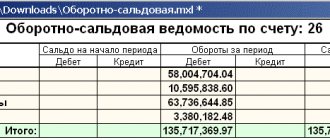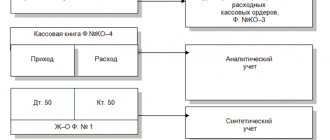The accrual of taxes and their payment is reflected in account 68 “Calculations for taxes and fees”. For more convenient accounting, account 68 is divided into several sub-accounts, each of which takes into account different taxes. Such a division will make accounting more transparent and make it clear which tax is owed to the budget, and which tax the organization owes. Similarly, account 69 “Calculations for social insurance and security” is divided into subaccounts. In the article we will talk about the features of accounting for account 68, and also consider typical transactions and examples of transactions with taxes and fees.
Count 68: features of use
Account 68 is used to reflect transactions for the calculation and transfer of taxes and fees that the organization pays to the budget of the federal and regional levels. As a rule, in account 68, enterprises post the amounts of obligations for value added tax (VAT), income tax (INP), property tax, etc.
The accrual of tax amounts is reflected in K68; when transferring funds to the budget and when accepting tax for deduction, D68 is used.
Let's look at typical wiring:
| Debit | Credit | Description | Document |
| 68 | 19 | The tax amount is written off as a credit (for the purchase of goods, services, works) | Consignment note, act |
| 68 | 50, 51, 55 | The tax amount is transferred to the budget | Payment order, cash order |
| 10, 15 | 68 | Inclusion in the cost of materials (stocks) is the amount of non-refundable tax | Packing list |
| 20, 23, 29 | 68 | The amount of accrued tax is taken into account in production expenses | Acts, invoices, limit-fence cards |
| 44 | 68 | Accrued tax is included in sales expenses | Acts, invoices, expense reports |
Types of accounting entries
All wiring can be divided into several types:
1. Changes in the property of the enterprise. This group includes only active and active-passive accounts. It assumes that the company's property is redistributed, but the balance does not change.
For example: Rozetka LLC transferred money from the cash register to a bank account to pay the supplier. This operation will be reflected by the posting: Dt 51 Kt 50, that is, we have less money in the cash register by 42,000, we put it in the current account.
2. Changes in the obligations of the enterprise. This group includes only passive and active-passive accounts. It assumes that the company's liabilities are redistributed without changing the balance sheet.
For example: Rozetka LLC agreed to reclassify the debt into a short-term loan. This operation will be reflected by the posting: Dt 60 Kt 66, that is, the debt to the creditor in the amount of 42,000 rubles turned into short-term liabilities for the same amount.
3. The liabilities and assets of the enterprise change - the balance increases. This group includes all types of accounts: for debit - active and active-passive, and for credit - passive and active-passive. In this case, both the assets and liabilities of the balance sheet increase.
For example: Rozetka LLC bought wires from a supplier for 42,000 rubles. Just in this case, our obligations to the supplier increased by 42,000 rubles and the cost of materials increased by 42,000 rubles.
4. The liabilities and property of the enterprise change - the balance decreases. This group includes passive and active-passive accounts for credit, and for debit - active and active-passive. In this case, the assets and liabilities of the balance sheet decrease.
For example: Rozetka LLC repaid the debt to the supplier from the current account. This operation will be reflected by the posting: Dt 60 Kt 51. In this case, we have less money in the current account and the debt to the supplier has disappeared.
In addition, all wiring can be divided into simple and complex. Simple transactions include only 2 accounts, but complex ones may have more. Moreover, each complex transaction can be reflected in several simple ones. This happens when we record receipts from two or more other accounts into one common account.
For example: Rozetka LLC bought from the supplier not only wires for 42,000 rubles, but also special equipment for 128,000 rubles. Complex wiring would look like this:
Dt 10 “Materials” - 42,000 rubles
Dt 07 “Equipment for installation” - 128,000 rubles
Kt 60 “Settlements with suppliers” - 170,000 rubles.
This complex wiring can be written in two simple ones:
Dt 10 Kt 60 - 42,000 rubles
Dt 07 Kt 60 - 128,000 rubles.
Complex entries, contrary to their name, make accounting easier because they reduce the number of entries. This saves a lot of time.
Video lesson: Account 68 in accounting.
Video lesson on basic operations on accounting account 68, key entries, practical examples. The lesson is taught by consultant and expert of the “Accounting for Dummies” website, chief accountant N.V. Gandeva. ⇓
You can download the presentation for the video lesson from the link below.
Download the presentation “Account 68 in accounting” in PDF format
| Buy ★ bestselling book “Accounting from scratch” for dummies (understand how to do accounting in 72 hours) > 8000 books purchased |
Typical entries for accounting for VAT on sales
Debit 90 Credit 68 - VAT accrual on sales of assets, works, services. The basis of the entry is the outgoing invoice.
Debit 76 Credit 68 - accrual of VAT on advances received. The basis is an advance invoice.
Debit 68 Credit 76 - reflection of the offset of VAT on advances upon completed shipment (performance of work, provision of services). The basis is the issued invoice.
Debit 08 Credit 68 - accrual of VAT on construction and installation works carried out in-house. The basis is an accounting certificate.
Debit 91 Credit 68 - VAT accrual for gratuitous transfer of assets. The posting is made on the basis of the issued invoice.
Debit 68 Credit 51 - VAT debt has been repaid. The basis is a bank statement.
If you have received an advance from the buyer, you can see what entries should be made for VAT in the Ready-made solution from ConsultantPlus experts. Get a free trial access to K+.
Reflection of transactions with VAT
Depending on the type of activity, an enterprise can carry out various VAT transactions. We will consider the main such operations using examples.
VAT when making a contribution to the authorized capital of another organization
In January 2021, Yantar JSC purchased from Rubin LLC a batch of construction and repair materials worth 48,350 rubles, VAT 7,375 rubles. In March 2021, Yantar JSC acquired a stake in the authorized capital of Amethyst JSC. The cost of the share is 54,280 rubles. Construction materials previously purchased from Rubin LLC were transferred to pay off the debt on the contribution to the authorized capital of Amethyst JSC.
These transactions were reflected in the accounting of Yantar JSC with the following entries:
| Debit | Credit | Description | Sum | Document |
| 10 | 60 | Construction materials purchased from Rubin LLC have been received (RUB 48,350 – RUB 7,375) | RUB 40,975 | Packing list |
| 19 | 60 | The amount of VAT on purchased building materials is reflected | RUR 7,375 | Invoice |
| 68 VAT | 19 | VAT on the cost of building materials is accepted for deduction | RUR 7,375 | Invoice |
| 58 | 76 | The acquisition of a stake in Amethyst JSC was taken into account | RUR 54,280 | Contract of sale |
| 76 | 10 | Reflected the transfer of construction materials to pay off the debt on the contribution to the authorized capital of Amethyst JSC | RUB 40,975 | Transfer and Acceptance Certificate |
| 19 | 68 VAT | The amount of VAT on purchased building materials, previously accepted for deduction, has been restored | RUR 7,375 | Certificate of acceptance and transfer of construction materials, Invoice |
| 58 | 19 | The amount of VAT recovered when making a contribution to the authorized capital of “Amethyst” is taken into account | RUR 7,375 | Certificate of acceptance and transfer of construction materials, Invoice |
| 76 | 91.1 | The amount of income from the transfer of building materials is taken into account (RUB 54,280 – RUB 40,975) | RUB 13,305 | Certificate of acceptance and transfer of construction materials, Invoice |
| 68 Income tax | 99 PNO | The amount of permanent tax asset is taken into account (RUB 13,305 * 20%) | RUB 2,661 | Accounting certificate-calculation |
VAT on sales of goods
In April 2015, JSC Everest sold LLC Kazbek a batch of goods - 12 inflatable boats for fishing:
- selling price of one boat – 94,350 rubles, VAT 14,392 rubles;
- unit cost of goods – 73,150 rubles.
The accountant of Everest JSC reflected these transactions with the following entries:
| Debit | Credit | Description | Sum | Document |
| 45 | 43 | The cost of a batch of boats sold by Kazbek LLC was taken into account (RUB 73,150 * 12 units) | 877.800 rub. | Costing |
| 76 | 68 VAT | The amount of VAT is reflected on the cost of sales (RUB 14,392 * 12 units) | RUB 172,704 | Invoice |
| 51 | 62 | Funds have been credited from Kazbek LLC as payment for a batch of inflatable boats (RUB 94,350 * 12 units) | 1,132,200 rub. | Bank statement |
| 62 | 90.1 | The amount of revenue from the sale of boats is taken into account | 1,132,200 rub. | Packing list |
| 90.2 | 45 | The cost of boats sold is written off as expenses | 877.800 rub. | Costing |
| 90.3 | 76 | The amount of VAT on revenue is taken into account | RUB 172,704 | Invoice |
VAT on the amount of advances received
An agreement was concluded between JSC Stimul and LLC Rubikon for the supply of cabinet furniture worth RUB 1,143,850, VAT RUB 174,486. On January 12, 2016, the supplier JSC Stimul received an advance payment in the amount of 100% of the cost of furniture delivery. On January 15, 2016, furniture was shipped from the warehouse of Stimul JSC to Rubicon LLC.
In the accounting of Stimul JSC, the accountant made the following entries:
| Debit | Credit | Description | Sum | Document |
| 51 | 62.2 | Funds have been credited from Rubikon LLC as an advance payment for the supply of cabinet furniture | RUB 1,143,850 | Bank statement |
| 76 Advances received | 68 VAT | The amount of VAT on the prepayment received is taken into account | RUR 174,486 | Invoice |
| 62.1 | 90.1 | Furniture was shipped from the warehouse of Stimul JSC to Rubikon LLC. | RUR 174,486 | Packing list |
| 90.3 | 68 VAT | The amount of tax on the sale of furniture is reflected | RUR 174,486 | Invoice |
| 62.2 | 62.1 | The repayment of the debt of Rubicon LLC with the previously transferred advance is reflected | RUB 1,143,850 | Bank statement, delivery note |
| 68 VAT | 76 Advances received | The VAT amount is accepted for deduction | RUR 174,486 | Invoice |
VAT upon termination of the contract
In June 2015, JSC Europe entered into an agreement with LLC Asia to carry out work to repair the production line of workshop No. 2. The cost of the work (327,350 rubles, VAT 49,934 rubles) was transferred as an advance to the bank account of Asia LLC. In August 2015, the contract with Asia LLC was terminated, the work was not completed, and the funds were returned to the account of JSC Europe.
When recording transactions, the accountant of Asia LLC made the following entries:
| Debit | Credit | Description | Sum | Document |
| 51 | 62 Advances received | Funds have been credited as an advance payment from JSC Europe for the repair of the production line of workshop No. 3 | RUR 327,350 | Bank statement |
| 62 Advances received | 68 VAT | The amount of VAT accrued on the advance received from JSC “Europe” | RUR 49,934 | Invoice |
| 68 VAT | 51 | The amount of VAT transferred to the budget is 1/3 of the amount of quarterly obligations (RUB 49,934 / 3 months) | RUR 16,644 | Tax return |
| 62 Advances received | 51 | Funds were transferred to JSC “Europe” as a return of a previously received advance | RUR 327,350 | Payment order |
| 68 VAT | 62 Advances received | The VAT amount is accepted for deduction | RUR 49,934 | Tax return |
VAT on free transfer of property
JSC “Mecenat” carried out a free transfer of diagnostic equipment to the “Health Center”:
- cost of equipment - 874,650 rubles;
- the price of diagnostic equipment according to the assessment report is RUB 1,112,420.
JSC “Mecenat” made the following postings:
| Debit | Credit | Description | Sum | Document |
| 91.2 | 41 | Transferred equipment is reflected in expenses | RUR 874,650 | Packing list |
| 91.2 | 68 VAT | The amount of VAT is taken into account (RUB 1,112,420 * 18% / 118%) | RUR 169,691 | Transfer and Acceptance Certificate |
Frequency of tax payment and reporting
Compliance with the deadlines for submitting reports and remitting taxes will allow you to avoid penalties and additional inspections of the activities of enterprises by tax authorities. As a rule, even in the absence of a taxable base and accruals, reporting is mandatory.
| Name of tax (payment) | Rates | Payment deadlines | Timing and type of reporting |
| VAT | 0% - for export; 10% - for food, children's goods, book products, medical products, etc.; 18% - for other goods and services. | Quarterly, no later than the 25th day of the month following the reporting quarter | The declaration is submitted electronically quarterly, no later than the 25th day of the month following the reporting quarter. |
| Income tax | 9% - income from interest on a number of government securities; 10% - income of non-resident carriers; 20% - basic rate; 30% - profit of foreign companies, profit from hydrocarbon production at sea, etc. | Quarterly, no later than the 28th day of the month following the reporting quarter | The declaration is submitted quarterly, no later than the 28th day of the month following the reporting quarter. |
| Personal income tax | 9% - on dividends until 2015, interest on mortgage-backed bonds issued before 2007; 13% is the base rate for individuals, including dividend income from 2015; 15% — dividends of non-resident individuals; 30% - other income of non-resident individuals; 35% - from winnings, prizes, etc. | At the time of payment of income | Register f. 2-personal income tax is provided by enterprises annually until April 1 of the reporting year |
| Excise taxes | Solid, ad valorem and combined, differentiated by type of goods | Monthly until the 25th day of the month following the reporting month, for straight-run gasoline and ethyl denatured alcohol - until the 25th day of the 3rd month following the reporting month | The declaration is submitted every month by the 25th day of the month following the reporting month, for straight-run gasoline and ethyl alcohol - by the 25th day of the 3rd month following the reporting month |
| Contributions to compulsory social insurance | 2.0-2.9% depending on the category of payers | Monthly, until the 15th day of the month following payment | Reporting according to f. 4-FSS quarterly until the 20th day of the month following the reporting quarter |
| Contributions to compulsory pension insurance | 22% | Monthly, before the 15th day of the month following the month of payment | Quarterly report on f. RSV-1 until the 15th day of the 2nd month following the reporting quarter |
| Property tax | Calculated based on cadastral value | Quarterly until the 30th day of the month following the reporting quarter, annually - until March 30 of the reporting year | The declaration is submitted quarterly by the 30th day of the month following the reporting quarter, for a year - by March 30 of the reporting year |
| simplified tax system | 6% of income or 15% of income minus expenses | Quarterly - advance payments until the 25th day of the month following the reporting quarter | Declaration annually by March 31 of the year following the reporting year - for LLCs, for individual entrepreneurs - by April 30 |
| Unified agricultural tax | 6% of income minus expenses incurred | For the 1st half of the year - until the 25th day of the month following the end of the half-year, for the year - until March 31 of the following year | Declaration annually before March 31 of the year following the reporting year |
| UTII | 15% of the amount of imputed income | Quarterly – advance payments due by the 25th day of the month following the reporting quarter | Declaration quarterly by the 20th day of the month following the reporting quarter |
| Patent system | 6% of potential income | When the patent is valid for up to 6 months. – in full amount until the expiration of the patent, more than 6 months. – 1/3 of the tax amount in the first 90 days, the remaining 2/3 until the expiration of the patent | Providing a declaration is not provided |
Accounting for income tax transactions
Let's look at an example of calculating and paying income tax (IPT).
Based on the results of the 3rd quarter of 2015, Topaz JSC received a profit of 1,941,800 rubles. Reflecting transactions with income tax in the 3rd quarter of 2015, the accountant of Topaz JSC made the following entries:
| Debit | Credit | Description | Sum |
| 99 | 68 NnP | The amount of conditional income tax is reflected in expenses (RUB 1,941,800 * 20%) | RUR 388,360 |
| 99 | 68 NnP | The amount of PNO is reflected in expenses | RUR 33,750 |
| 68 NnP | 77 | The resulting deferred tax liability was taken into account | 4,350 rub. |
| 77 | 68 NnP | Repayment of deferred tax liability is reflected | 2,150 rub. |
| 09 | 68 NnP | The resulting deferred tax asset was taken into account | 9,120 rub. |
| 68 NnP | 09 | The repayment of the deferred tax asset is reflected | RUR 3,430 |
To determine the amount of NNP, the accountant of Topaz JSC made the following calculation:
the amount of the current NNP is 425,600 rubles. ((388,360 rub. + 33,750 rub. – (4,350 rub. – 2,150 rub.) + (9,120 rub. – 3,430 rub.)).
This indicator corresponds to the information specified in the tax return.
Payment for NNP was reflected in the following entries:
| Debit | Credit | Description | Sum | Document |
| 68 NnP | 51 | The amount of NnP for the 3rd quarter of 2015 was transferred to the federal budget | RUB 42,560 | Payment order |
| 68 NnP | 51 | The amount of NnP for the 3rd quarter of 2015 was transferred to the local budget | RUR 383,040 | Payment order |
How to prepare accounting entries
To draw up accounting entries that will correctly reflect events occurring in the organization, you need to follow the rules:
- Chronological order . Postings must be made clearly in the sequence of their execution.
- Systematization . All similar transactions must be reflected in the same accounts.
- Documentary validity . Accounting entries can only be made on the basis of primary documents.
- Monetary expression . Postings are made only in monetary terms.
Beginner accountants often get confused about postings. But they are quite simple to compose if you understand the meaning of the operation. We'll tell you how to do it.
Step 1 . Determine which accounts you are using for the transaction. To do this, refer to the working chart of accounts. Selecting the right account is not difficult - their names clearly explain what transactions they are intended to account for. For example, account 60 “Settlements with suppliers” or account 10 “Materials”.
Step 2 . Organize accounts into debits and credits. To do this, you need to clearly remember that all accounts are divided into active, passive and active-passive. Active accounts increase by debit, and passive accounts by credit. Active-passive accounts are the most complex - they grow by debit or credit, depending on the transaction being reflected.
Step 3 . Make entries using the double entry principle.
Now let's look at this process using an example
Example: Rozetka LLC purchased a set of wires worth 42,000 rubles. How to make a wiring?
Let's analyze the operation: we received materials from the supplier, which means there are more of them in the warehouse, and we now have to pay the supplier money for the purchase.
Step 1 . Wires are the materials that we need to complete the work, which means we take them into account under account 10 “Materials”. All transactions with suppliers are accounted for in account 60 “Settlements with suppliers”.
For posting we need accounts 10 and 60.
Step 2 . Materials are our assets, which means the receipt of materials increases the number of our assets. Account 10 is active, so it increases by debit.
Debt to the supplier forms accounts payable. Its appearance means that the liability has increased. Account 60 is active-passive, but in this case it will increase in credit.
Step 3 . We will make entries using the double entry principle
| Debit | Credit | Sum |
| 10 | 60 | 42 000 |
Subaccounts of account 68
68.1 – intended to reflect calculations for personal income tax.
68.2 – reflects information on the calculation and payment of VAT.
68.3 – intended for accounting for excise taxes.
68.4 – for the calculation and payment of income tax.
68.7 – the subaccount can be used by owners of vehicles paying transport tax.
68.8 – data on the calculation and payment of property tax is reflected.
Depending on the specifics of the activity and the applied tax regime, additional sub-accounts may be opened, for example:
68.11 – UTII
68.12 – simplified tax system
The debit of account 68 is intended to record paid amounts of taxes and fees transferred to the budget. The debit also indicates the VAT presented by suppliers and sent for deduction (reimbursement from the budget).
The debit of account 68 corresponds with the credit of accounts, which reflect the movement of funds (cash, non-cash), as well as with the credit of account 19 “VAT on purchased assets”.
The credit of account 68 is intended to reflect the amounts of accrued taxes that are subject to payment to the budget.
The credit to account 68 corresponds with the debit of various accounts, the choice of which depends on the type of tax.
What is an accounting entry
An accounting entry is a way of recording information about a company's activities in the accounting accounts. Each transaction involves two accounts and one amount.
Accounting accounts are fixed in the Chart of Accounts - it contains 99 balance sheet and 11 off-balance sheet accounts. This plan is required for all commercial organizations, but each of them has its own working chart of accounts that it applies. It is not necessary to include all the accounts listed in the Order of the Ministry of Finance; you can choose those that you yourself will use.
Accounting accounts are linked to each other by debit and credit, each transaction is accounted for by the debit of one account and the credit of another. This is called the double entry principle.



